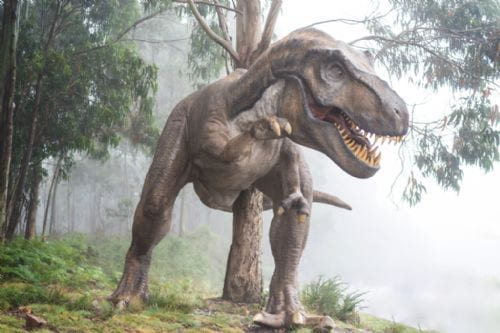Battle of the Bites: ‘King of the Dinosaurs’ Bite Was Weaker than Tiny Finch
10 January 2019
Tyrannosaurus rex evolved to have a bite that was less powerful in relation to its body size than a tiny Galapagos ground finch, new research has found. The study, led by scientists at the University of Reading alongside researchers at the University of Lincoln has shown that the T-rex’s evolution was not driven by a […]

Tyrannosaurus rex evolved to have a bite that was less powerful in relation to its body size than a tiny Galapagos ground finch, new research has found.
The study, led by scientists at the University of Reading alongside researchers at the University of Lincoln has shown that the T-rex’s evolution was not driven by a need for a powerful bite to kill its prey. The dinosaur’s bite force of 57,000 Newtons was in fact average for its 8 tonne body mass.
In comparison, a Galapagos large ground finch was found to have the most powerful bite in relation to its body size of all of the animals in the study with a bite force of 70 Newtons and an average body mass of just 33 grammes. Pound-for-pound, this makes the bite force of the finch around 320 times more powerful than T-rex.
Scientists used supercomputers to analyse the largest ever collection of bite force data from 434 species both extinct and surviving, including reptiles, birds and mammals. They investigated the theory that animals with more powerful bites were forced to rapidly evolve that way due to changes to their diets.
They instead found that the bite power of most of these animals developed proportionally to evolutionary changes to their body size over time, with only some seeing their bite forces develop at a faster rate than other changes.
Accelerated bursts of bite power evolution were seen in some animals, especially finches – a species famously first noted as an example of natural selection by Charles Darwin. However, expected increases along with body size during the passage of time was seen to be the most common driver of this trait. For example, research showed that the finch’s powerful bite evolved in less than one million years, much faster than that of T-rex which took tens of millions of years.
The team even observed more dramatic reductions in bite forces during evolution than increases. This was true for early humans, whose bite power decreased rapidly despite their body size increasing over time.
The research also suggests human intelligence may have led to us having an extremely weak bite due to the evolution of our larger brains which take up space in our heads where the muscles critical for hard biting would otherwise be.
Marcello Ruta a palaeontologist from the University of Lincoln’s School of Life Sciences and co-author of the study said: “Exactly 180 years ago, Charles Darwin wrote his preliminary notes on the extraordinary variation in bill shape among the Galapagos finches he had discovered a few years earlier. At that time, fossils of the fearsome T. rex had not yet been unearthed. How curious that such humble creatures – the finches – which contributed so much to Darwin’s thinking, would add a new unexpected spin to our understanding of the forces (and bite forces) behind evolution”
Dr Manabu Sakamoto, biological scientist at the University of Reading and lead author of the study, said: “The image of T. rex with its fierce jaws has helped it become the most iconic of dinosaurs, but our research shows its bite was relatively unremarkable. Bite force was not what gave T. rex its evolutionary advantage, as was previously presumed.
“Large predators like T. rex could generate enough bite force to kill its prey and crush bone just by being large, not because they had a disproportionately powerful bite. This counters the idea that an exceptionally strong need for a powerful bite drove these ancient beasts to evolve bone-crushing bite forces.”
Dr Chris Venditti, University of Reading, co-author on the study, said: “Our research provides new insight into the latest theories about the speed and drivers of evolution. It also allows us to create some fascinating hypothetical match-ups.”
The authors argue that the study,
published in the Royal Society journal Proceedings B
,shows the course of evolutionary history should not be ignored when looking at how animals developed distinctive traits.
